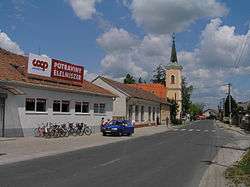Dolný Štál
Dolný Štál (Hungarian: Alistál, Hungarian pronunciation:[ˈɒliʃtaːl]) is a village and municipality in the Dunajská Streda District in the Trnava Region of south-west Slovakia.
Dolný Štál Alistál | |
|---|---|
village | |
 | |
 Location of the village | |
| Coordinates: 47°59′01″N 17°34′36″E | |
| Country | |
| Region | Trnava |
| District | Dunajská Streda |
| First written mention | 1111 |
| Government | |
| • Mayor | Horváth Tamás [1] (Party of the Hungarian Coalition) |
| Area | |
| • Total | 29.99 km2 (11.58 sq mi) |
| Elevation | 112 m (367 ft) |
| Population (2001)[2] | |
| • Total | 1,962 |
| • Estimate (2008) | 1,966 |
| • Density | 66/km2 (170/sq mi) |
| Ethnicity | |
| • Hungarians | 94.19% |
| • Slovaks | 5.40% |
| Time zone | UTC+1 (EET) |
| • Summer (DST) | UTC+2 (EEST) |
| Postal Code | 930 10 |
| Area code(s) | +421 31 |
| Website | www |
Geography
The municipality lies at an altitude of 112 metres and covers an area of 29.997 km². It has a population of 1,962 people.
History
In the 9th century, the territory of Dolný Štál became part of the Kingdom of Hungary. In historical records the village was first mentioned in 1111. Until the end of World War I, it was part of Hungary and fell within the Dunaszerdahely district of Pozsony County. After the Austro-Hungarian army disintegrated in November 1918, Czechoslovakian troops occupied the area. After the Treaty of Trianon of 1920, it became officially part of Czechoslovakia and fell within Bratislava County until 1927. In November 1938, the First Vienna Award granted the area to Hungary and it was held by Hungary until 1945. After Soviet occupation in 1945, Czechoslovakian administration returned and the village became officially part of Czechoslovakia in 1947.
Demography
In 1910, the village had 1040, in 1991 the census indicated 1889, while the 2001 census 1962 inhabitants. The village has an absolute Hungarian majority.
References
- Local election 2010 results by the Statistical Office of the Slovak Republic Archived August 11, 2011, at the Wayback Machine
- "Institute of Informatics and Statistics". Archived from Institute of Informatics and Statistics the original Check
|url=value (help) on 2011-02-26. (in English)
Genealogical resources
The records for genealogical research are available at the state archive "Statny Archiv in Bratislava, Slovakia"
- Roman Catholic church records (births/marriages/deaths): 1713-1905 (parish A)
- Lutheran church records (births/marriages/deaths): 1823-1946 (parish B)
- Reformated church records (births/marriages/deaths): 1783-1902 (parish A)
External links
- Alistál in the news (in Hungarian)
- Surnames of living people in Dolny Stal